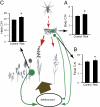Herbivore physiological response to predation risk and implications for ecosystem nutrient dynamics
- PMID: 20713698
- PMCID: PMC2932623
- DOI: 10.1073/pnas.1009300107
Herbivore physiological response to predation risk and implications for ecosystem nutrient dynamics
Abstract
The process of nutrient transfer through an ecosystem is an important determinant of production, food-chain length, and species diversity. The general view is that the rate and efficiency of nutrient transfer up the food chain is constrained by herbivore-specific capacity to secure N-rich compounds for survival and production. Using feeding trials with artificial food, we show, however, that physiological stress-response of grasshopper herbivores to spider predation risk alters the nature of the nutrient constraint. Grasshoppers facing predation risk had higher metabolic rates than control grasshoppers. Elevated metabolism accordingly increased requirements for dietary digestible carbohydrate-C to fuel-heightened energy demands. Moreover, digestible carbohydrate-C comprises a small fraction of total plant tissue-C content, so nutrient transfer between plants and herbivores accordingly becomes more constrained by digestible plant C than by total plant C:N. This shift in herbivore diet to meet the altered nutrient requirement increased herbivore body C:N content, the C:N content of the plant community from which grasshoppers select their diet, and grasshopper fecal C:N content. Chronic predation risk thus alters the quality of animal and plant tissue that eventually enters the detrital pool to become decomposed. Our results demonstrate that herbivore physiology causes C:N requirements and nutrient intake to become flexible, thereby providing a mechanism to explain context dependence in the nature of trophic control over nutrient transfer in ecosystems.
Conflict of interest statement
The authors declare no conflict of interest.
Figures


Similar articles
-
Linking predation risk, herbivore physiological stress and microbial decomposition of plant litter.J Vis Exp. 2013 Mar 12;(73):e50061. doi: 10.3791/50061. J Vis Exp. 2013. PMID: 23524884 Free PMC article.
-
Fear of predation slows plant-litter decomposition.Science. 2012 Jun 15;336(6087):1434-8. doi: 10.1126/science.1220097. Science. 2012. PMID: 22700928
-
Temperature dependence of predation stress and the nutritional ecology of a generalist herbivore.Ecology. 2016 Nov;97(11):3119-3130. doi: 10.1002/ecy.1524. Epub 2016 Oct 4. Ecology. 2016. PMID: 27870021
-
How Nutrients Mediate the Impacts of Global Change on Locust Outbreaks.Annu Rev Entomol. 2024 Jan 25;69:527-550. doi: 10.1146/annurev-ento-120220-110415. Annu Rev Entomol. 2024. PMID: 38270985 Review.
-
The ecological significance of tallgrass prairie arthropods.Annu Rev Entomol. 2006;51:387-412. doi: 10.1146/annurev.ento.51.110104.151136. Annu Rev Entomol. 2006. PMID: 16332217 Review.
Cited by
-
A diabetes-like biochemical and behavioural phenotype of Drosophila induced by predator stress.Proc Biol Sci. 2023 Jul 12;290(2002):20230442. doi: 10.1098/rspb.2023.0442. Epub 2023 Jul 5. Proc Biol Sci. 2023. PMID: 37403506 Free PMC article.
-
Dietary choice for a balanced nutrient intake increases the mean and reduces the variance in the reproductive performance of male and female cockroaches.Ecol Evol. 2016 Jun 12;6(14):4711-30. doi: 10.1002/ece3.2243. eCollection 2016 Jul. Ecol Evol. 2016. PMID: 27547307 Free PMC article.
-
Short-term exposure to predation affects body elemental composition, climbing speed and survival ability in Drosophila melanogaster.PeerJ. 2016 Aug 4;4:e2314. doi: 10.7717/peerj.2314. eCollection 2016. PeerJ. 2016. PMID: 27602281 Free PMC article.
-
For flux's sake: General considerations for energy-flux calculations in ecological communities.Ecol Evol. 2021 Sep 14;11(19):12948-12969. doi: 10.1002/ece3.8060. eCollection 2021 Oct. Ecol Evol. 2021. PMID: 34646445 Free PMC article.
-
Towards an integrated understanding of dietary phenotypes.Philos Trans R Soc Lond B Biol Sci. 2023 Dec 4;378(1891):20220545. doi: 10.1098/rstb.2022.0545. Epub 2023 Oct 16. Philos Trans R Soc Lond B Biol Sci. 2023. PMID: 37839453 Free PMC article. Review.
References
-
- Lindeman RL. The trophic-dynamic aspect of ecology. Ecology. 1942;23:399–418.
-
- Post DM. The long and short of food-chain length. Trends Ecol Evol. 2002;17:269–277.
-
- Gruner DS, et al. A cross-system synthesis of consumer and nutrient resource control on producer biomass. Ecol Lett. 2008;11:740–755. - PubMed
-
- Hutchinson GE. Homage to Santa Rosalia or why are there so many kinds of animals? Am Nat. 1959;93:145–159.
-
- Elser JJ, et al. Nutritional constraints in terrestrial and freshwater food webs. Nature. 2000;408:578–580. - PubMed
Publication types
MeSH terms
Substances
LinkOut - more resources
Full Text Sources

